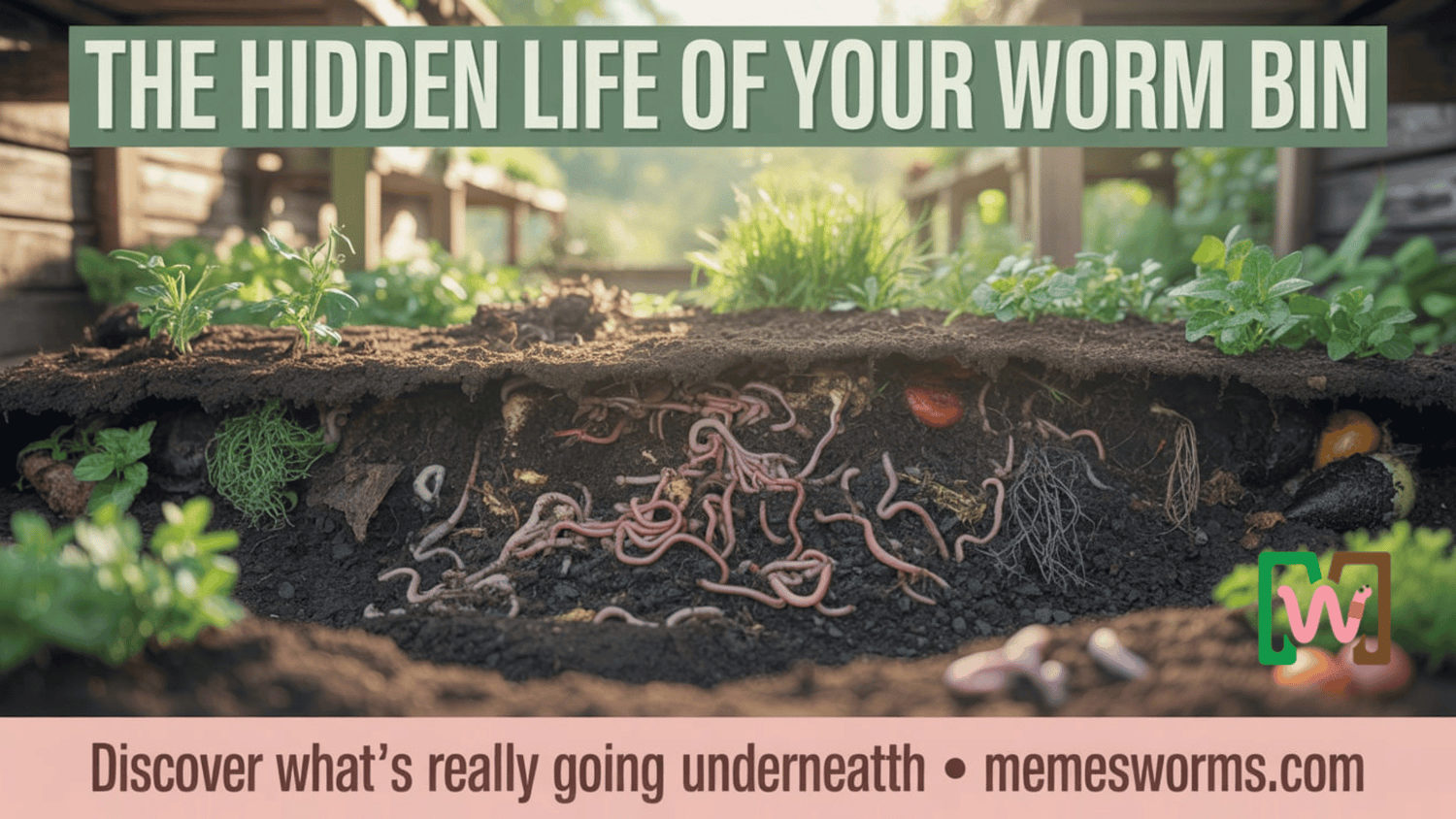Most people think worm composting is simple — toss in a few food scraps, close the lid, and wait for “black gold,” right? But beneath that layer of cardboard and castings lies an entire world of life, movement, and transformation.

Your worm bin isn’t just a box of worms — it’s a living, breathing ecosystem. Every banana peel you drop in sparks a microscopic feeding frenzy that turns yesterday’s leftovers into tomorrow’s garden power.
In this post, we’ll lift the lid (literally) and explore what’s really happening under the surface — how your worms, microbes, and bedding all work together in perfect harmony to build rich, living soil.
The Ecosystem of the Worm Bin
When you lift the lid of your worm bin, you’re not just looking at worms and old lettuce — you’re looking at a tiny world that’s alive, balanced, and constantly working. Your bin is an ecosystem, a mini version of the forest floor.
Every piece of bedding, every drop of moisture, every little movement beneath the surface plays a part in the recycling magic.
Inside, it’s not just the worms doing the heavy lifting.
You’ve got bacteria, fungi, springtails, and other tiny decomposers that team up to break down your scraps into a form your worms can handle.
It’s like a natural assembly line — the microbes soften and pre-digest the food, then the worms move in to finish the job and convert it into nutrient-rich castings.

Think of it like a slow-motion symphony:
-
The bedding acts as both the stage and the safety net, providing structure and air flow.
-
The microbes are the opening act — starting the breakdown process.
-
The worms are the headline performers — turning waste into pure, plant-loving gold.
-
And finally, the castings are the encore — rich, earthy, and ready to supercharge your soil.
A healthy worm bin works because everything inside has a role. When it’s balanced, it doesn’t smell bad, it stays moist but not soggy, and your worms are active and happy. The best part? Once this ecosystem hits its groove, it practically takes care of itself.
What Happens When You Feed Compost Worms
Every time you toss a banana peel or a handful of coffee grounds into your worm bin, something amazing begins to happen — and it’s happening whether you see it or not. That food doesn’t just sit there and rot; it enters a natural process of transformation that’s as old as life itself.
First, the microbes clock in. They swarm over the new food scraps, breaking down the sugars and fibers into simpler compounds. If you listen close (and had a microscope), you’d witness a bustling micro-city of bacteria and fungi turning yesterday’s leftovers into tomorrow’s soil nutrients.
Next, your worms move in for the feast. They don’t actually have teeth — instead, they suck in the softened material, grinding it up in their gizzards with tiny bits of grit and bedding. What comes out the other end are perfectly processed castings — tiny, nutrient-packed granules that plants absolutely love.
Here’s what’s happening under the lid in slow motion:
-
You feed them → fresh scraps hit the surface.
-
Microbes multiply → food begins to break down.
-
Worms move in → they eat, aerate, and mix everything up.
-
Castings form → the bin turns darker, richer, and more alive.

You’ll start to notice subtle signs when the system is thriving: the bedding feels like damp soil, not sludge. There’s a soft, earthy smell. And if you dig gently, you’ll see little worm trails — signs of life, work, and harmony beneath the surface.
When everything’s running smoothly, your worm bin becomes a quiet factory of fertility. You’re not just feeding worms — you’re fueling an entire micro-ecosystem that feeds your garden in return.
Silent Alarms — What Your Worm Bin Is Trying to Tell You
Your worm bin might not make noise (well, unless you count a little squirming), but it does have a way of communicating. If you pay attention, you’ll notice when it’s happy — and when it’s quietly calling for help.
A balanced worm bin smells earthy and fresh — like a walk through the woods after it rains. But when something’s off, your bin sends out signals.
Here’s what your worms might be trying to tell you:
“It Smells Bad In Here!”
A strong, sour, or rotten odor means things are breaking down without enough air. That’s anaerobic activity — and worms hate it.
Fix it fast:
-
Fluff or stir your bedding to add airflow.
-
Mix in dry bedding (shredded cardboard or coconut coir).
-
Hold off feeding for a few days to let things rebalance.
“We’re Drowning Down Here!”
Too much moisture suffocates worms and their microbial helpers. If bedding feels slimy or water is pooling, it’s time to dry things out.
Fix it fast:
-
Add dry bedding and mix gently.
-
Leave the lid cracked open for a day or two.
-
Avoid juicy scraps like melons or citrus until things even out.

“You’re Feeding Us Too Much!”
Overfeeding is a classic beginner mistake. If you see uneaten food piling up or fruit flies moving in, your worms can’t keep up.
Fix it fast:
-
Feed only when most of the last batch is gone.
-
Stick to smaller portions and spread scraps around.
-
Try freezing and thawing scraps to help them break down faster.
“We’re Slowing Down…”
If your worms are sluggish or trying to escape, it’s usually a temperature or pH issue.
Fix it fast:
-
Keep the bin between 60–80°F.
-
Avoid acidic foods like citrus and tomatoes.
-
Add a little crushed eggshell to help balance pH.
The best worm bins run like quiet little cities — everything has a rhythm, and when one part gets off-beat, the others feel it.
When you start noticing these small signs and responding early, your worms reward you with faster composting, fewer problems, and better-quality castings.
It’s like they’re saying, “Thanks for listening, human. Now pass the banana peel.”
How to Keep Your Worm Bin's Ecosystem Thriving
Once your worm bin is balanced, your job shifts from “setup mode” to “maintenance mode.” The goal now is to keep the little underground ecosystem thriving — and the secret is consistency.
Think of your bin like a pet you only feed every few days. It doesn’t need constant attention, but it does need the right mix of food, moisture, bedding, and airflow to stay happy. A few small habits will keep your worms working at peak performance and your compost looking like dark, crumbly soil instead of mushy leftovers.

Here’s how to keep your system running smoothly:
Keep It Cozy
Worms love it when temperatures stay between 60°F and 80°F.
If it’s too cold, they slow down. Too hot, and they panic.
Tip: Keep your bin somewhere shaded and stable — a garage, laundry room, or shaded porch works great.
Bedding Is the Foundation
Your bedding is where worms live, breathe, and lay eggs. Without good bedding, your bin can’t stay balanced.
Use materials like shredded cardboard, coconut coir, or EcoFluff Bedding from Meme’s Worms — soft, breathable, and designed to hold moisture without going soggy.
Moisture Matters
If your bedding feels like a wrung-out sponge, you’re golden.
Too dry and worms will struggle to move and eat. Too wet and they’ll suffocate.
Pro Tip: Keep a spray bottle nearby for light misting and add dry bedding if it starts getting swampy.
Feed Mindfully
Worms eat half their body weight per day, but it’s better to underfeed than overfeed.
Add food in small amounts and check back every few days. When most scraps are gone, it’s time for the next meal.
Best foods: banana peels, apple cores, leafy greens, coffee grounds, and shredded paper bedding.
Avoid: meat, dairy, citrus, or anything oily.
Harvest Regularly
After a few months, your bin will start producing that rich, black “worm gold” — the castings. Harvesting every 3–4 months keeps the bin from compacting and gives your worms room to breathe.
You can use a simple sorting tray, or try a worm sifter to make separation fast and clean.
Trust the Process
Remember, worm composting is a rhythm — not a race.
You’re working with nature, not against it. Once your bin finds its groove, it’ll quietly do its job with little help from you.
The secret to a thriving ecosystem?
Feed your worms right, keep their home comfy, and let them handle the rest.
And if you ever need the good stuff — bedding, worms, or ready-to-use castings — you already know where to go:
💚 www.memesworms.com
Conclusion: The Beauty Beneath the Surface Of A Worm Bin
Worm composting isn’t just about turning kitchen scraps into soil — it’s about witnessing nature’s quiet genius at work. Every peel, core, and coffee ground becomes part of a living cycle that gives back more than it takes. Inside your bin, billions of tiny organisms are creating something far greater than the sum of its parts: life.

So the next time you feed your worms, pause for a second.
That squirming mass of red wigglers isn’t just composting — they’re rebuilding the foundation of healthy soil, one bite at a time. 🌎
If you nurture the ecosystem inside your worm bin, it’ll reward you with lush gardens, thriving plants, and the kind of satisfaction that only comes from working with nature, not against it.
And when you’re ready to take your worm bin to the next level, we’ve got you covered — from premium red wigglers to Vermifusion Worm Bedding and nutrient-packed castings, all tested and trusted by real worm farmers.
Build your best worm bin yet at www.memesworms.com — where healthy soil starts one worm at a time.



Leave a comment
All comments are moderated before being published.
This site is protected by hCaptcha and the hCaptcha Privacy Policy and Terms of Service apply.